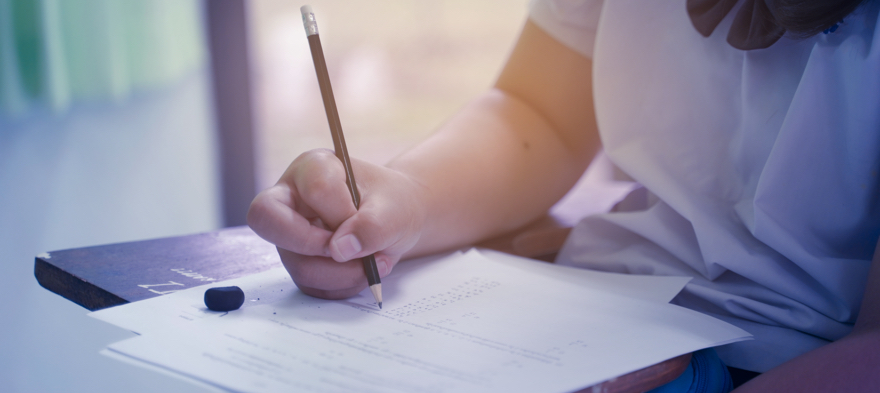
Sometimes, data can seem pesky. Just ask the folks who continue to suggest that coronavirus spikes are merely the result of increased testing. “You know why we have so many [coronavirus] case numbers?” President Trump asked an audience in Florida last month. “Because we do more testing than any country in the world. There’s plenty good about testing, too. The bad thing is you find cases.” It’s easy to shake your head when you know the whole story—that COVID-19 cases are surging much faster than daily testing rates.
However, there is at least one truth that we can glean from claims like these: [pullquote]The more you set out to measure something that’s happening in the world, the more chances you have to find something you don’t like.[/pullquote]
That’s especially true in education, where having good data can make the difference between students getting the interventions they need or falling through the cracks. While states typically obtain this data from exams in core subjects like reading and math, school closures in the spring forced most states to dispense with state testing altogether.
And since the U.S. Department of Education recently announced the postponement of the 2021 administration of the Nation's Report Card, we will lose what's likely our only opportunity to gather comparable state-by-state information on the extent of learning loss in reading and math, after months of school closures.
Now, as school districts around the country are pulling out all the stops to blunt the learning losses that have occurred since March, the need for data is more evident than ever. Whether you call it pesky, inconvenient, or downright painful, [pullquote]having student data right now is crucial for school districts trying to develop a meaningful plan for addressing learning loss.[/pullquote] Without it, we can't fight for our students’ futures.
Data has long been considered crucial in helping schools and parents work together to close learning gaps. Based on what we're seeing so far, it's only going to get more important as students try their best to weather this crisis.
In economics, a "K-shaped" recovery is when wealthy individuals recover and exceed and those in poverty trend downwards. Based on the evidence we have now, there's a good chance that's happening with education during COVID-19 too.
Advantaged kids may actually be outpacing their usual school year by learning at home, especially if they have the technology and support available to excel in their learning. Meanwhile, disadvantaged kids could be losing up to months of learning rapidly. Without data to show us exactly what's happening, getting these kids back on track to succeed will be a real task.
The good news is that most major school districts across the country are still continuing to measure student performance amid the many educational challenges brought on by the pandemic. According to a new report from the Center on Reinventing Public Education (CRPE), 80 of the nation’s 100 highest-profile school systems either diagnosed entering students’ learning loss at the beginning of the year or are planning to monitor student progress throughout the year, or both. [pullquote position="right"]While the data may not be what educators and parents would like to see, it at least gives schools a starting point for addressing learning loss.[/pullquote]
In Dallas, for example, testing data showed that 50% of students are behind in math and 30% are behind in reading compared to where they were in December 2019. While that may seem bleak, these insights have paved the way for an $80 million proposal that could help create targeted interventions for struggling students in 100 schools across the district.
And in D.C., data on early childhood literacy indicated that the achievement gap between White students and students of color has been widening since schools closed in the spring. City leaders and education officials have pointed to this data to create a sense of urgency around safely reopening schools for in-person learning.
However, while most school districts are planning to have assessments in place to measure student learning, the bad news is that collecting data is only one part of the big picture. Districts still have their work cut out for them in using that data to develop a plan for addressing students’ learning losses. Based on what we know so far, those losses are significant.
But kids are resilient. [pullquote]Teachers and parents may be challenged and exhausted, but we must have hope that can work through this crisis together[/pullquote] and contribute meaningfully to our students' learning. Data, as pesky as it may sometimes seem, is just the first step of the way.
Garris Stroud is an award-winning educator and writer from Greenville, Kentucky whose advocacy and scholarship have been recognized by USA Today, U.S. News and World Report, Education Post, The Louisville Courier-Journal, and The Lexington Herald-Leader. He served as a Hope Street Group Kentucky State Teacher Fellow from 2017-2019 and became chair of the organization's editorial board in 2018. Stroud received bachelor's and master's degrees in education from Murray State University and is currently a doctoral student in educational leadership at the University of the Cumberlands, located in the heart of Kentucky's Appalachian region. Read more about his work on the Kentucky School Talk and Rural Ed Voices blogs.
The fight for educational equity has never been just about schools. The real North Star for this work is providing opportunities for each child to thrive into adulthood. This means that our advocacy...
Your donation will support the work we do at brightbeam to shine a light on the voices who challenge decision makers to provide the learning opportunities all children need to thrive.
Ed Post is the flagship website platform of brightbeam, a 501(c3) network of education activists and influencers demanding a better education and a brighter future for every child.
© 2020–2024 brightbeam. All rights reserved.